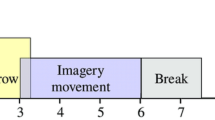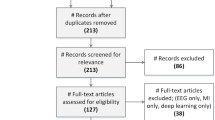Abstract
The using of Electroencephalography (EEG) signals for motor imagery (MI) has recently gained significant attention due to their remarkable ability to detect an individual’s intention to perform specific actions. MI signals have proven useful in enabling individuals with disabilities to control devices such as wheelchairs through neural commands, and have even expanded into applications like autonomous driving. Therefore, ensuring accurate classification of MI tasks from EEG signals is crucial for the development of a reliable Brain-Computer Interface (BCI) system. This article introduces a novel approach to classifying MI tasks using Deep Learning (DL) techniques. The proposed methodology encompasses several steps, including data preprocessing, feature extraction using Common Spatial Pattern (CSP) and Wavelet Packet Decomposition (WPD), and the evaluation of four distinct classifiers. These classifiers involve combinations of two, three, four, and five Convolutional Neural Networks (CNNs). Empirical evaluations highlight the effectiveness of employing five CNNs, which yield the most favorable results. Our approach demonstrates promising performance metrics such as accuracy, precision, recall, and F1 score. Specifically, the method achieves accuracy, precision, recall, and F1 score values of 64.75%, 64.94%, 65.63%, and 64.13%, respectively, indicating its potential to enhance the accuracy of MI task classification within EEG signals.







Similar content being viewed by others

Data availability
The dataset used in this study is public and can be found at the following links: https://www.bbci.de/competition/iv/.
References
Yang S, Tan J, Chen B (2022) Robust spike-based continual meta-learning improved by restricted minimum error entropy criterion. Entropy 24:455. https://doi.org/10.3390/e24040455
Yang S, Chen B (2023) Effective surrogate gradient learning with high-order information bottleneck for spike-based machine intelligence. IEEE Trans Neural Netw Learn Syst 22. https://doi.org/10.1109/TNNLS.2023.3329525
Benezeth Y, Jodoin PM, Saligrama V et al (2009) Abnormal events detection based on spatio-temporal co-occurrences. In: 2009 IEEE Conference on computer vision and pattern recognition. IEEE, pp 2458–2465. https://doi.org/10.1109/CVPR.2009.5206686
Chang Y, Tu Z, Xie W et al (2022) Video anomaly detection with spatio-temporal dissociation. Pattern Recogn 122:108213
O’Shea K, Nash R (2015) An introduction to convolutional neural networks. arXiv:1511.08458. https://arxiv.org/abs/1511.08458
Soleymani S, Dabouei A, Kazemi H, Dawson J, Nasrabadi NM (2018) Multi-level feature abstraction from convolutional neural networks for multimodal biometric identification. 2018 24th International Conference on Pattern Recognition (ICPR), Beijing, China, pp 3469–3476. https://doi.org/10.1109/ICPR.2018.8545061
Li E, Xia J, Du P, Lin C, Samat A (2017) Integrating multilayer features of convolutional neural networks for remote sensing scene classification. IEEE Trans Geosci Remote Sens 55(10):5653–5665
Amin SU, Alsulaiman M, Muhammad G, Mekhtiche MA, Hossain MS (2019) Deep learning for EEG motor imagery classification based on multi-layer CNNs feature fusion. Futur Gener Comput Syst 101:542–554
Zhao X, Zhang H, Zhu G, You F, Kuang S, Sun L (2019) A multi-branch 3D convolutional neural network for EEG-based motor imagery classification. IEEE Trans Neural Syst Rehabil Eng 27:2164–2177
Schirrmeister RT, Springenberg JT, Fiederer LDJ, Glasstetter M, Eggensperger K, Tangermann M, Ball T (2017) Deep learning with convolutional neural networks for EEG decoding and visualization. Hum. Brain Mapp 38:5391–5420. https://doi.org/10.1002/hbm.23730
Bashivan P, Rish I, Yeasin M, Codella N (2015) Learning representations from EEG with deep recurrent-convolutional neural networks. arXiv:1511.06448. https://arxiv.org/abs/1511.06448
Tortora S, Ghidoni S, Chisari C et al (2020) Deep learning-based BCI for gait decoding from EEG with lstm recurrent neural network. J Neural Eng 17(4):046011
Zhang K, Robinson N, Lee SW et al (2021) Adaptive transfer learning for EEG motor imagery classification with deep convolutional neural network. Neural Netw 136:1–10
Lee J, Nam J (2017) Multi-level and multi-scale feature aggregation using pretrained convolutional neural networks for music auto-tagging. IEEE Signal Process Lett 24(8):1208–1212. https://doi.org/10.1109/LSP.2017.2713830
Zhang P et al (2017) Amulet: Aggregating multi-level convolutional features for salient object detection. In: Proceedings of the IEEE International Conference on Computer Vision
Bhattacharjee P, Das S (2017)Two-stream convolutional network with multi-level feature fusion for categorization of human action from videos pattern recognition and machine intelligence. PReMI. In: Lecture Notes in Computer Science, Vol. 10597, Springer, Cham
Hariharan B, Arbelaez P, Girshick R, Malik J (2015) Hyper-columns for object segmentation and fine-grained localization. In: Proceedings of the IEEE International Conference on Computer Vision, pp 447–456
Ueki K, Kobayashi T (2015) Multi-layer feature extractions for image classification — Knowledge from deep CNNs. In: 2015 International Conference on Systems, Signals and Image Processing (IWSSIP), London, 2015, pp 9–12
Sakhavi S, Guan C, Shuicheng Y (2018) Learning temporal information for brain-computer interface using convolutional neural networks. IEEE Trans Neural Netw Learn Syst 29(11):5619–5629
Tabar YR, Halici U (2017) A novel deep learning approach for classification of EEG motor imagery signals. J Neural Eng 14(1):016003
Yang J, Yao S, Wang J (2018) Deep fusion feature learning network for MI-EEG classification. IEEE Access 6:79050–79059
Zhang D, Chen K, Jian D, Yao L (2020) Motor imagery classification via temporal attention cues of graph embedded EEG signals. IEEE J Biomed Health Inf 24(9):2570–2579
Roots K, Muhammad Y, Muhammad N (2020) Fusion convolutional neural network for cross-subject EEG motor imagery classification. Computers 9(3):72
León J, Escobar JJ, Ortiz A, Ortega J, González J, Martín-Smith P, Gan JQ, Damas M (2020) Deep learning for EEG-based motor imagery classification: accuracy-cost trade-off. PLoS ONE 15:e0234178
Grosse-Wentrup M, Liefhold C, Gramann K, Buss M (2009) Beamforming in noninvasive brain computer interfaces. Biomed Eng IEEE Trans 56(4):1209–1219
Parra LC, Spence CD, Gerson AD, Sajda P (2005) Recipes for the linear analysis of EEG. Neuroimage 28(2):326–341
Ramoser H, Muller-Gerking J, Pfurtscheller G (2000) Optimal spatial filtering of single trial EEG during imagined hand movement. IEEE Trans Rehabil Eng 8:441–446
Zheng W, Lin Z (2009) Optimizing multi-class spatio-spectral filters via Bayes error estimation for EEG classification. In: Proc Adv Neural Inf Processing Syst, pp 2268–2276
Majidov I, Whangbo T (2019) Efficient classification of motor imagery electroencephalography signals using deep learning methods. Sensors 19:1736. https://doi.org/10.3390/s19071736
Thanh N, Imali H, Amin K, Lee G-B, Chee PL, Saeid N (2018) Classification of multi-class BCI data by common spatial pattern and fuzzy system. IEEE Access 6:27873–27884. https://doi.org/10.1109/ACCESS.2018.2841051
Acknowledgements
This research work was funded by Institutional Fund Projects under grant no. (IFPIP: 1137-135-1443). The authors gratefully acknowledge technical and financial support provided by the Ministry of Education and King Abdelaziz University, DSR, Jeddah, Saudi Arabia.
Funding
The authors received no financial support for the research, authorship, and/or publication of this article.
Author information
Authors and Affiliations
Contributions
Conceptualization was done by AE. All the literature reading and data gathering were performed by AE. All the experiments and coding were performed by AE. The formal analysis was performed by AE. Manuscript writing original draft preparation was done by AE, WZ, MG. Review and editing was done by AE, WZ, MG. Visualization work was carried out by AE, WZ, MG.
Corresponding author
Ethics declarations
Ethics approval and consent to participate
Not applicable.
Consent for publication
Not applicable.
Competing interests
No conflict of interest to report.
Additional information
Publisher’s Note
Springer Nature remains neutral with regard to jurisdictional claims in published maps and institutional affiliations.
Rights and permissions
Springer Nature or its licensor (e.g. a society or other partner) holds exclusive rights to this article under a publishing agreement with the author(s) or other rightsholder(s); author self-archiving of the accepted manuscript version of this article is solely governed by the terms of such publishing agreement and applicable law.
About this article
Cite this article
Echtioui, A., Zouch, W. & Ghorbel, M. Merged CNNs for the classification of EEG motor imagery signals. Multimed Tools Appl 84, 373–395 (2025). https://doi.org/10.1007/s11042-024-18892-8
Received:
Revised:
Accepted:
Published:
Issue Date:
DOI: https://doi.org/10.1007/s11042-024-18892-8



